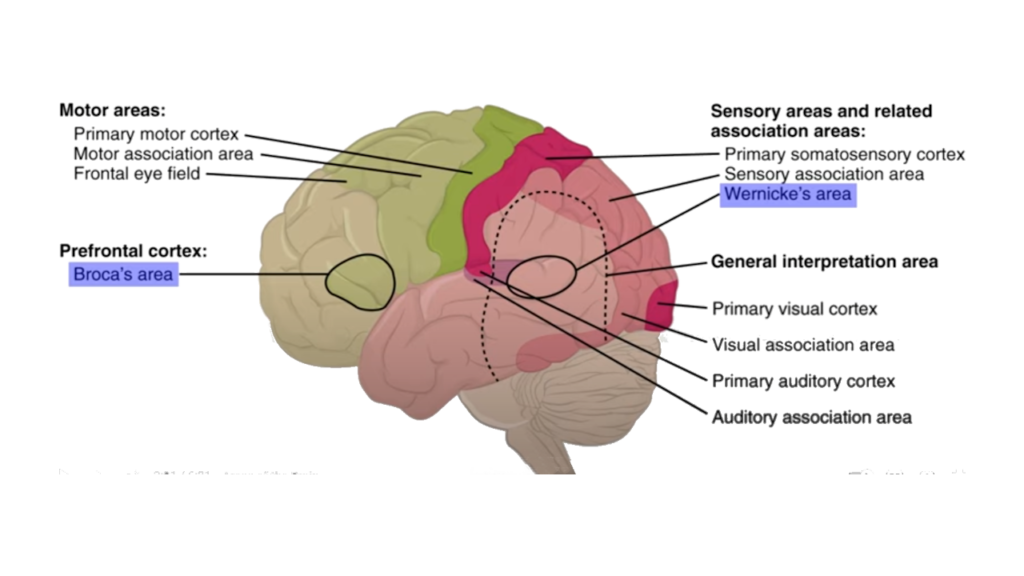The human brain — and how it functions — has fascinated scientists for millennia. Scholars note, “In ancient Greece, Alcmaeon of Croton (sixth-fifth century BC) recognized the brain as a central organ responsible for higher activities such as intelligence, memory, and thought.”[1] Among those higher human activities is the ability to speak. “The ability of humans to use language is among the things that make them distinct from other animals,” explains tech journalist Rhodi Lee, “but scientists were not certain as to why and how this trait has evolved.”[2] She goes on to explain that one theory, developed by Thomas Morgan and his colleagues, is that humans developed speech so they could teach others how to make tools, hunt cooperatively, and pass along other essential knowledge. She writes, “The first verbal communications, which likely happened 2.5 million years ago, were likely about tool-making. The study proposes that our human ancestors in the African savannah may have developed a primitive form of language so they could teach each other how to make stone age tools, a crucial skill for survival at the time.”
University of California, Berkley, professors, Nina F. Dronkers, Maria V. Ivanova, and Juliana V. Baldo, a clinical research scientist, insist we don’t fully appreciate language until we can’t communicate. They write, “Language is a skill that most of us take for granted. We use it automatically and, for the most part, effortlessly, and can enjoy participating in conversations without having to think about the rapid computations that occur in our brains as we speak. It allows us to have our own unique form of social interaction and facilitates our ability to solve complex problems. It allows us to write our ideas down on paper and read what others have said, even over distant locations or periods of time. Language is, in fact, a significant part of what makes us human.”[3] The fact that a person can lose the ability to communicate, due to stroke or accident, motivated scientists and doctors to explore more deeply the relationship between the brain and language.
Freelance writer Moheb Costandi reports, “In the 1860s, Pierre Paul Broca’s post-mortem examinations of stroke patients with language deficits identified an area of the left frontal lobe involved in speech production. At around the same time, Karl Wernicke identified another region located in the temporal lobe that was damaged in stroke patients who had lost the ability to understand spoken language.”[4] He adds, “In the latter part of the 20th century, the development of brain scanning techniques such as functional magnetic resonance imaging (fMRI) enabled researchers to understand the functions of these language centers in greater detail, divide them further into distinct subregions, and see how they recover from stroke damage. Brain scan studies have also shown that a network of regions in the left frontal and temporal lobes map the form of words to their meanings and put them together to form phrases and sentences.” The following video provides an excellent introduction to the Wernicke-Geschwind Model which attempts to explain how these “networks of regions” work together to help us communicate.
As medicine and medical techniques advance, new discoveries are constantly being made. Costandi reports, “Researchers have created a cellular map of semantic information, revealing how cells in the frontal cortex encode word meanings and how they are organized. Ziv Williams, a neurosurgeon at Massachusetts General Hospital, and his colleagues had the rare opportunity to examine these processes in 10 patients with drug-resistant epilepsy as they were being evaluated for neurosurgery.” Using microelectrodes attached to patients’ brains, Williams and his team were able to monitor responses to specific words. Costandi reports, “The researchers found that many of the neurons responded selectively to related words with specific meanings. For example, some cells fired when the participants heard words describing foods such as carrot, cake, and salad. Others responded to words denoting objects, such as broom, car, and lampshade. Verbs elicited sweeping changes in activity for the largest number of cells, whereas words describing spatiotemporal relationships — such as up, down, and behind — elicited limited changes. And while most of the neurons fired only in response to words within one category, several responded to words in two.”
Williams told Costandi, “One of the surprising findings is that even small focal cortical areas may be potentially able to represent complex meanings largely in their entirety. Areas such as the one we recorded may contain broad mixtures of different cells, each responding to different word meanings to provide a rich and detailed representation of the linguistic information communicated through speech.” While these new findings are interesting, for Williams the exciting part is that they may lead to new ways to help patients regain the power of language. He explains, “We were able to decode the meaning of words from a relatively small number of cells, suggesting that it may be possible to read out meanings and concepts from the activity patterns of neurons during natural speech processing. Such a capacity could be useful for the future development of speech prostheses that aim to decode the meaning of words from neuronal activity rather than their motor representations.” He adds, “We are interested in studying whether similar semantic representations may be observed across languages or in bilingual speakers and whether accessing word meanings in language comprehension and production elicit similar responses. We are also interested in determining how meanings are represented in other parts of the brain outside the prefrontal cortex, and how these may be used for the development of speech prostheses.”
Dronkers, Ivanova, and Baldo write, “When language is taken away from us — as can happen after a brain injury — we are forced to realize how valuable it is and how much we depend on it in our everyday lives. We begin to understand how complicated language is, the many different ways in which it can be affected, and how difficult it is to regain once it is lost. Thus, the study of language disorders after an injury to the brain has helped us to understand more about the building blocks of human language, how these change after injury, and hopefully, how we can use this information to assist those who have been afflicted.” Williams and his colleagues are doing just that. Their research might also contribute to the field of artificial intelligence and how computer networks can cooperate to improve understanding.
P. Thomas Schoenemann, a professor of anthropology at the University of Indiana who studies the evolution of brain size and function, concludes, “There is a complex interplay between language evolution and brain evolution. … Because language is critical to an individual’s adaptive fitness, language also likely had a fundamental influence on brain evolution. Humans are particularly socially interactive creatures, which makes communication central to our existence.”[5] As artificial intelligence systems mature, they will need to gain the same type of understanding of language as the human brain. Communication is as essential for machine intelligence as it is for human intelligence.
Footnotes
[1] Bem LS Jr., Lemos NB, de Lima LF, Dias AJ, Marques JC, Lira C, et al. The anatomy of the brain – learned over the centuries. Surg Neurol Int 2021;12:319.
[2] Rhodi Lee, “Stone Age Butchery Tools Influenced Language Evolution More Than You Think,” Tech Times, 15 January 2015.
[3] Nina F. Dronkers, Maria V. Ivanova, and Juliana V. Baldo, “What Do Language Disorders Reveal about Brain–Language Relationships? From Classic Models to Network Approaches,” Journal of the International Neuropsychological Society, 04 December 2017.
[4] Moheb Costandi, “Decoding the brain’s dictionary: Scientists map how neurons encode word meanings,” Big Think, 23 September 2024.
[5] P. Thomas Schoenemann, “Evolution of Brain and Language,” Indiana University, 2009.





